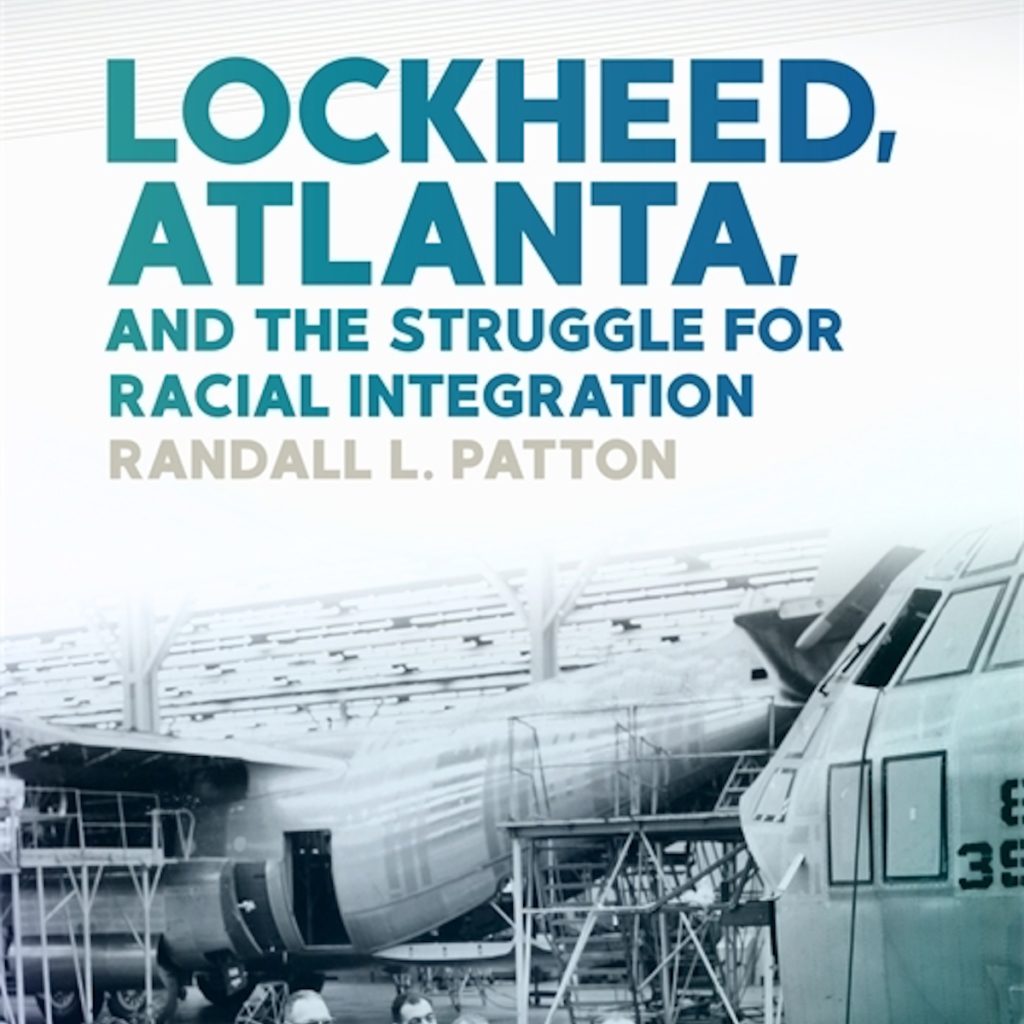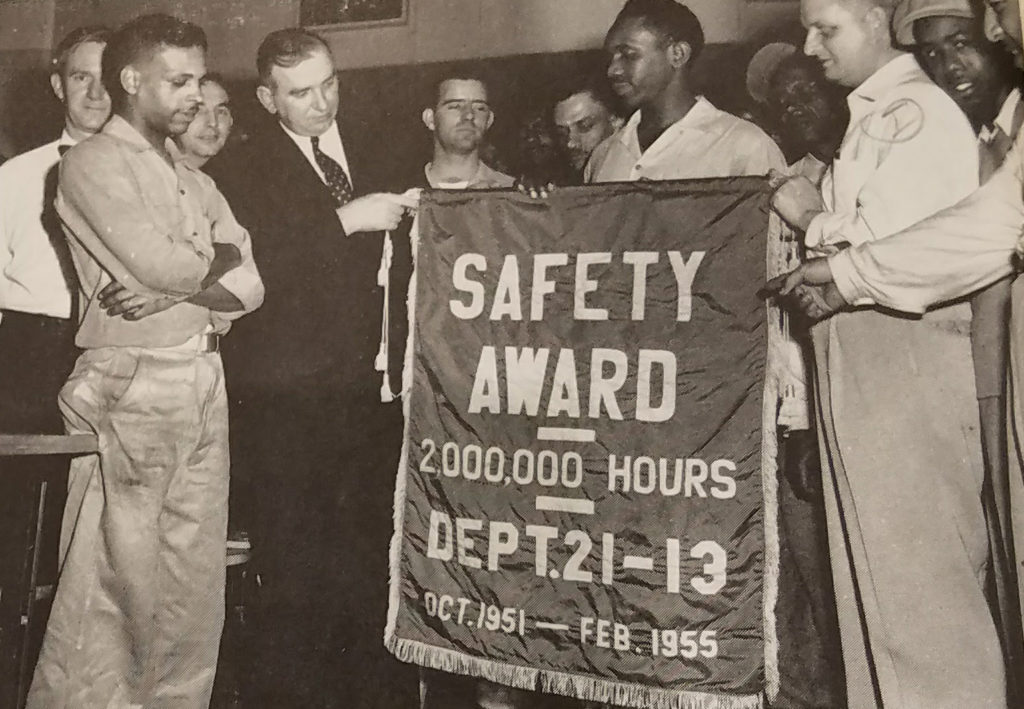In the following excerpt drawn from the third and fourth chapters of his forthcoming book Lockheed, Atlanta and the Struggle for Racial Integration (Athens: University of Georgia Press, 2019), author Randall L. Patton discusses the experiences of African American workers at the Lockheed-Georgia Plant in Marietta in the 1950s and how the culmination of their frustrations in a 1961 complaint filed with President Kennedy’s new Committee on Equal Employment Opportunity would ultimately set the stage for the development of a new national initiative for workplace desegregation and equal opportunity in employment known as Plans for Progress.
Excerpted from Lockheed, Atlanta and the Struggle for Racial Integration by Randall L. Patton. Copyright © 2019 University of Georgia Press. Used with permission of the publisher, University of Georgia Press. All rights reserved.

In early 1961, Lockheed-Georgia and its workers, white and black, faced an uncertain future.
By the end of the 1950s, the market for Lockheed-Georgia’s prime product, the C-130 Hercules, had, in business parlance, matured. The aircraft would continue in production in one form or another for decades and continue to provide jobs, but the very high production numbers of the mid-1950s fell as the market became saturated. The long life of aircraft often created boom-and-bust cycles for aircraft workers, and by 1960, another bust was on the horizon: unless additional C-130 orders came in, layoffs loomed. But in February 1961, shortly after President Kennedy’s inauguration, the Defense Department awarded Lockheed a contract for an additional sixteen C-130Bs. Still, the new order would only keep the production line running for less than another two years. Many in the Atlanta area feared that employment at the plant would shrink even further or that the plant would close entirely, short-circuiting regional growth plans.
Then, in mid-March, the U.S. government offered Lockheed-Georgia an even larger prize: a $1 billion contract to produce a new transport plane with greater capacity, range, and speed than the C-130. Lockheed outbid Boeing, Douglas, and Convair to produce the new plane, which became known as the C-141 Starlifter. Lockheed pledged to subcontract 62 percent of the new aircraft and “place the subcontracts in economically distressed areas of the South and East.”1 In other words, Lockheed promised to help the government manage the contract as an economic development program. The contract, which was slated to last between ten and fifteen years, would add five thousand jobs at Lockheed’s main Georgia plant. In a front-page article announcing the contract, the Atlanta Constitution characterized it as “one of the biggest pieces of economic news in Georgia for a long time, with far reaching effects.”2

“The recession-etched frown on Georgia’s economic face gave way to a broad smile Monday night,” wrote the Constitution’s Marion Gaines, summarizing the reaction of Georgia’s business and political elite to the news.3 Ivan Allen Jr., soon to be elected mayor of Atlanta, “lauded the anticipated spillover effects of related business activity,” while the president of the state Chamber of Commerce called it “a terrific breakthrough for Georgia’s economy.”2 Cobb County Commissioner Herbert McCollum called it “one of the happiest days we’ve had in Cobb County in a long time,” adding that he believed that the contract would spark a resurgence of construction.2 Senator Herman Talmadge observed that the deal would “make possible the retention of Lockheed as Georgia’s single largest manufacturing employer.”2
And the Atlanta area received more economic good news that same week when first Delta Air Lines added nonstop routes from Atlanta to both Los Angeles and San Francisco, and then the Southern Cement Company – headquartered in Birmingham, Alabama – announced plans for a new multimillion-dollar cement plant near Atlanta in anticipation of new construction boom. The president of the state Chamber of Commerce referred to the trio of announcements as “the beginning of a new era of expansion for the state,” and suggested that these “good tidings” should “serve as documentation . . . that the South is the last economic frontier in the country.”4

Marietta, metropolitan Atlanta, and Georgia generally seemed poised for an era of economic growth supported and subsidized by what Noam Chomsky has called the “dynamic state sector,” focused on aircraft, electronics, computers, transportation, and weapons technology. Observers who might have opposed massive spending on a variety of alternative public services and projects loudly cheered federal appropriations for programs in these areas. Indeed, many business and community leaders considered such expenditures “an essential part of our economy,” as a 1958 Rockefeller Brothers Fund report put it.5 Within the broad liberal consensus sketched by analysts from Godfrey Hodgson to Jennifer Delton, what the Rockefeller report called “public expenditures in support of growth” were crucial.6 While there was room for debate within the consensus about just what kinds of public expenditures supported growth and which might be wasteful, defense-related spending generated little disagreement during the Cold War era.
Demanding their “Fair Share”
But at this point, Lockheed-Georgia’s path to long-term stability encountered a potential roadblock. During the 1960 presidential campaign, John F. Kennedy had promised action on equal employment, and on March 6, 1961, just a week before the Lockheed contract announcement, he issued Executive Order 10925.7 The order replaced the President’s Committee on Government Contracts (PCGC) with the President’s Committee on Equal Employment Opportunity (PCEEO). Much longer than previous orders on equal employment, Executive Order 10925 required contractors “to take affirmative action to ensure that applicants are employed, and that employees are treated during employment, without regard to their race, creed, color, or national origin.” This requirement extended to “employment, upgrading, demotion or transfer; recruitment or recruitment advertising; layoff or termination; rates of pay or other forms of compensation; and selection for training, including apprenticeship.”2 Moreover, the order contained a “but not limited to” clause that opened the door to unspecified aspects of the employer-employee relationship and recognized the role of organized labor in racial discrimination, instructing the PCEEO to “use its best efforts,” directly and through contractors and contracting agencies, to secure union compliance with the order. Finally, the order took the unprecedented step of outlining penalties, up to and including cancellation of contracts, for failure to comply.
In contrast to his predecessors, Kennedy issued the equal opportunity employment order with great fanfare, accompanied by a press conference, touting the “vastly strengthened machinery” that would enable “vigorous enforcement” and thus demonstrating a “concerted effort to place the full prestige of the presidency behind the moral imperative of nondiscrimination.”8 As much as any substantive difference in language, the Kennedy administration’s projection of activism and intent marked a break with the past. The PCEEO, to be chaired by Vice President Lyndon Baines Johnson, scheduled its first meeting for April 11, amid rising expectations among African Americans and civil rights organizations.
Many African American workers at Lockheed-Georgia and in the surrounding area, however, believed that, absent dramatic changes in management policies and behavior, black gains would continue to be as limited as they had been in the previous decade – a few more jobs but not much else. And on March 20, a group of black workers unsuccessfully sought to be served in one of Lockheed’s white-designated cafeterias, provoking “considerable unrest” among black workers.9 In response, on March 27, 1961, Lockheed-Georgia’s director of industrial relations E. G. Mattison reprised a 1955 meeting with African American employees at the office of civil rights attorney Donald Lee Hollowell. And Lockheed-Georgia board member and former gubernatorial candidate James Carmichael was again called in to help mediate as a consequence of company officials’ fears that “any incident of sufficient magnitude could cause the Government to switch the contract to . . . one of our competitors.”10 African American employees attending the meeting presented Mattison and Carmichael with a list of demands that reiterated their complaints from six years earlier – too few black hires, lack of opportunity for advancement, and segregated facilities – which had now assumed an increased importance. Mattison assured the workers that the “company would continue to give consideration to the problems of the Negroes.”2
Nonetheless, the following day, current and former black Lockheed employees formed the Observatory Council on Discrimination to launch “an all-out campaign to eliminate . . . unfair, discriminatory, and segregated practices” at the Marietta location. According to the Atlanta Daily World, the Observatory Council immediately “set up active contact and communications with certain federal agencies whose interest lies in discrimination at government contracted companies” and had already initiated a complaint with the PCEEO.11 The group was determined that “Negroes must have a fair share of the” job opportunities created by the new contract. In addition, the group aimed to root out segregationist practices in all areas of the plant, including cafeterias, restrooms, and other facilities, and claimed “100 percent backing of its program by the entire Negro force at Lockheed.” And, the Observatory Council warned, “alleged unfair or discriminatory practices at the plant could hamper final decision of the contract.”2
At the same time, NAACP president Roy Wilkins wrote to Johnson and the PCEEO to protest continued segregation and discrimination at Lockheed-Georgia, suggesting a “reexamination and possible cancellation” of the contract.12 The letter included a litany of by-now familiar charges drawn from the complaints, among them discriminatory hiring and promotion practices, segregated time clocks and race coding of time cards, and segregated facilities. According to the letter, the Marietta facility was13
operated on a rigidly racially segregated basis . . . in direct contravention to the letter and spirit of the President’s executive Order.

The Reverend Samuel Williams, president of the Atlanta branch of the NAACP, declared that “we have been concerned about Lockheed for a long time” and suggested that it was “time for Lockheed to get in step with the rest of the nation.”2
The 1961 President’s Committee Complaints
In the days following Wilkins’s letter, thirty-six African American Lockheed employees signed affidavits making specific allegations of discrimination to buttress the NAACP’s case. The vast majority of these complainants had been hired in 1952–53 and had spent most of the remainder of the decade at the Marietta facility. As such, the affidavits they filed in conjunction with their complaints provide detailed insights into life on the Lockheed shop floor during this era.
Expressing a common complaint, J. O. Wyatt, a Morehouse graduate who applied for work at Lockheed in 1955, noted that “after completing my training, I was assigned to . . . an all Negro manned department” – “all Negro,” that is, with the exception of the white supervisor, who had a seventh-grade education and “no prior aircraft experience.”14 Moreover, Wyatt did not receive an upgrade from assembly helper to assembly installer until he filed a grievance based on work performed: in essence, the company accepted his assessment that he had been doing the installer’s job without the classification or pay increase. Further, Wyatt noted, in his six years at Lockheed, “there has never been a Negro apprentice in any trade.”2
Another affidavit was filed by Willie T. Elkins, who had spent eight years in the U.S. Army and had attended Morehouse College before becoming one of the first African Americans hired by the Atlanta Police Department in 1948.15 After resigning from the department briefly to finish his Morehouse degree, Elkins rejoined the force and spent two years as a policeman and an additional seven months as a probation officer before seeking employment at Lockheed.16 Elkins had been recruited by Robert Kennon, a Morehouse College graduate who had been hired in 1952 to recruit black workers. In early March 1953, Kennon told Elkins that Lockheed had an opening in the personnel department; however, managers at Lockheed’s Atlanta employment office told Elkins that the personnel job “was not open at this time.” Instead, they invited him to apply for a temporary position in production and wait for the personnel job to become available. Elkins quit his job as an Atlanta probation officer and was hired as a production worker at Lockheed on April 3, 1953.2 But, though Elkins “was told, in essence, that Lockheed was a division of a California corporation and that discrimination was not company policy,” he had already noticed that the plant maintained the customs of everyday segregated life in the South – White and Colored signs on restrooms, drinking fountains, cafeterias, and even time clocks. Kennon assured Elkins that these symbols of segregation were “a result of local law and custom” and did not reflect the company’s underlying attitude.2 After a month of training, Elkins was assigned to one of the crews working on the B-47 nose section.
According to Elkins’s affidavit, after Kennon left Lockheed in the mid-1950s, Elkins renewed his request for a transfer to the personnel department and was interviewed for the position, but nothing came of the interview.17 However, the personnel department hired another African American man, T. W. Hinds, who subsequently confided his disappointment in the position to Elkins. Hinds reported that he “had no job as such because he had no specific duties.”18 According to Elkins, Hinds had no access to personnel files and had simply “been told to circulate among the Negroes and to report the general attitudes and feelings of the men in regard to any incident or occurrence that might warrant company interest.”2 When personnel officials discovered that a black worker named Patterson had lost an eye in an off-the-job accident but had continued his employment – a violation of company policy for his particular position – Hinds was “sent down to talk Mr. Patterson into resigning.”2 On another occasion, Hinds was directed to investigate the “attitudes of the Negroes” toward the “in-plant arrest” of a black worker.2 Hinds “considered this type of duty degrading,” Elkins recalled, and “resented the fact that he had no opportunity to apply his administrative skills.”2 When a frustrated Hinds finally left Lockheed and accepted a lower-paying job elsewhere, he was asked to “sign a statement to the effect that he would not divulge the nature of his position with Lockheed.”19

John B. Mabry, another military veteran and college graduate, also joined Lockheed in April 1953. After training, Mabry became a structures assembler and received a promotion to inspector of structures in May 1957, only to be downgraded back to structures assembler five months later. Like most of the others who filed complaints in 1961, Mabry singled out segregated restroom and cafeteria facilities, time clocks, and discrimination in upgrades and promotions as the most important grievances, though he noted that the White and Colored signs had been removed from the time clocks in the past two years and replaced by a less overt system in which employee numbers – coded by race – were used to assign workers to time clocks. And like Elkins, Mabry accused the company and the union of colluding to keep black employees from advancing.20
Mabry’s complaint alleged that the company had failed to take into account his education and experience when considering his applications for upgrades. Given that he held a college degree and had worked as a medical technician while in the navy, he believed that he should have had “an opportunity to hold a classification in areas other than ‘shooting rivets.’”2 Mabry asserted that “the records will verify that members of the Caucasian race” with as little as sixth-, seventh-, or eighth-grade educations had held a half dozen or more job classifications and that whites who had “less than a high school education” had been promoted to production supervisor posts and given responsibility “over Negroes with college degrees.”2
Moreover, during his service on the International Association of Machinists’ labor relations committee, Mabry had “observed evidence of many ‘side agreements’ made by [business] agents and other members of the official family of the union . . . for the primary purpose of perpetuating segregation and racial discrimination.”2 Mabry thus believed that the union did not truly represent its members’ interests and was instead colluding with management to their detriment. According to Mabry, black workers believed that grievances regarding upgrades, transfers, and promotions were often mysteriously settled or dropped after going through the first couple of stages of the process.2 Elkins echoed Mabry’s charges, contending that there had been “indications of collusion” and that “there exists a general feeling of dissatisfaction among the Negroes at Lockheed in regards to the union and its relations with the Negro membership.”21
The segregated IAM local had been a source of frustration for Lockheed’s African American employees since at least the mid-1950s. Beginning in 1954, the IAM constitution prohibited the chartering of new segregated locals but allowed existing segregated locals to continue to operate as long as they did so on a “voluntary” basis. On October 13, 1957, the Atlanta Daily World had published an open letter from Alfred “Tup” Holmes, an African American union representative and activist who had previously sued the city of Atlanta to force the desegregation of its golf courses. Holmes explained that fifteen months earlier, seven black Lockheed employees had filed a complaint with the President’s Committee on Government Contracts alleging discrimination at the Marietta plant. The committee sent a team to investigate. “Sensing a whitewash,” Holmes wrote, he and his colleagues had asked the NAACP to monitor the investigation to “insure a complete and accurate appraisal of conditions at Lockheed.”22 After NAACP labor secretary Herbert Hill conferred with investigators and conducted his own inquiry, he met with black union members, probably in November 1956, and recommended that “to obtain complete equality,” the segregated local should disband and its members should join the existing all-white Lockheed IAM lodges.23 The members present voted unanimously to accept the recommendation.24 The vote must have been considered unofficial or advisory, however, and according to Holmes, several subsequent “efforts to secure an official vote have been unsuccessful because a few persons have apparently taken a stand ‘that we will not have representation if we merge, because our people will not go to union meetings.’”25 In Holmes’s view, “the real reason” for opposition to the merger was that it would “cause some members of the [black] local to lose positions, [along] with the doubtful prestige that goes with such jobs.”2 Although Holmes believed that the decision to create a separate local had been “well meaning . . . in the beginning,” the time for union integration had long since arrived. Only if all workers were truly united could the union effectively represent their interests. Or as he proclaimed: “The reactionary forces of the State of Georgia could ask for no better support of segregation than to have a vote from us to continue” to operate segregated locals.2
On the same day that Holmes’s letter appeared, the members of the African American local again voted to disband. Nevertheless, the union’s District 33 executive committee, which included the presidents of the four white lodges and the black lodge, recommended against the merger. In addition, the executive committee recommended that the district fight “any force[d] merger” by appealing first to the union’s International Council and if need be to the National Convention, which would not meet again until 1960. In addition, delegates from one of the white lodges called for the attorney general of Georgia to be notified of the proposed “forced merger” and asked to rule on its legality vis-à-vis the state’s Jim Crow laws. Finally, according to Elkins, G. H. Andrews, the president of the black local, had met with district and company officials and “challenged the validity of the meeting” at which the black employees had voted in favor of the merger, causing “the majority of the membership to become discouraged. There was a growing feeling that the president of the local was working to perpetuate himself in office and was indifferent to the attitudes of the membership.” Attendance at meetings of the black local declined precipitously, making it impossible to achieve a quorum to take any further action, and the merger idea went no further. When Elkins, Mabry, and their compatriots filed their complaints in 1961, Lockheed’s IAM locals remained segregated.
Plans for Progress
Lockheed officials initially defended the Georgia division’s record over the previous decade and shifted blame toward prevailing social mores. According to a Georgia company official who was not named in either the Atlanta Constitution or the Atlanta Daily World,
The problem that is being faced today is not one that we brought to Georgia. It was a problem that was already here. Lockheed has very conscientiously and vigorously done everything humanly possible to comply in all regulations in the operation of this facility. We are quite proud of our record in dealing with our employees over the past 10 years . . . We recognize that there is more progress yet to be made, but . . . we believe we have made more progress than any individual employer in the South in providing for all its employees. We think that any objective look at the record will show how well we have done.26
By alluding to the “problem that was already here,” Lockheed came close to stating publicly that although it had found local customs distasteful, it had been forced to engage in a delicate balancing act, following custom as far as possible while trying to provide opportunity for all its employees, implicitly including black workers. As such, Lockheed’s Georgia-based management ultimately believed that the NAACP had unfairly targeted the company even though many other firms were far more deserving of the bad publicity and stockholder heartburn that resulted from the controversy. Yet the frustrations of African Americans at Lockheed were real and of long standing, as Mattison and some of his colleagues increasingly realized.
Accordingly, in negotiations with the President’s Committee later that year, Mattison and his colleagues drew up a plan of affirmative action designed to produce measurable progress toward desegregation at Lockheed-Georgia. And soon after, at the suggestion of Robert Battey Troutman Jr. – white Atlanta attorney and member of the President’s Committee on Equal Employment Opportunity (PCEEO) – the Lockheed plan would become the model for the Kennedy administration’s new approach to equal employment opportunity, dubbed Plans for Progress (PfP). From 1961 until 1965, when the equal employment provisions of the Civil Rights Act of 1964 became effective, the quasi-voluntary, public-private Plans for Progress program represented the chief national response to African American demands for action on jobs.27


While African American workers made some significant gains, they also continued to bump into familiar limits. An April 1963 New York Times article reported on the “quiet side” of integration in Atlanta and included a statement from Harold Arnold, director of vocational services for the Atlanta Urban League, that many African Americans had recently gained jobs in businesses that had previously hired only whites, but he did not wish to name the firms.28 A longer version of the same story published in Missouri’s St. Joseph News-Press, offered an explanation that did not appear in the Times version: Arnold “would not name the firms involved” because they had requested anonymity, fearing that the news that they were equal-opportunity employers “would be harmful in handling other employees.”29 The message was none too subtle: keeping quiet created space for progress; agitation might wreck the entire integration enterprise.
Nevertheless, during this period, plans for hundreds of companies were generated and approved by the PCEEO, with limited but positive results. Whitney Young of the Urban League was initially a vocal critic of the program but in 1963 he “announced that 115 companies in Plans for Progress had hired nearly 15,000 new blacks in the third quarter of that year—25 percent of new workers in these companies were black. Before Plans for Progress, blacks had never made up more than 3 percent of new workers in any quarter.”30
With the crafting of the PfP approach, personnel executives also began taking a leading role in what Frank Dobbin calls “a new social movement” that differed dramatically from the civil rights movement, which was based on popular mobilization and which had spurred executive orders and legislation. The movement “emerged within the personnel profession to carry the civil rights project forward,” and Lockheed-Georgia played a major role in this “new social movement.”31 E.G. Mattison and Howard Lockwood, high-level personnel executives whom Lockheed loaned to Plans for Progress, helped define national programs. Hugh Gordon, increasingly Lockheed’s designated equal employment specialist, became perhaps the most important figure in promoting equal employment practices and policies to other businesses and community organizations. Lockheed’s managers and workers continued the long but important process of racial integration in corporate America.
To learn more about the Plans for Progress and other aspects of the long struggle for racial integration at Lockheed-Georgia from the 1950s through the 1980s, read Randall L. Patton’s forthcoming UGA Press book Lockheed, Atlanta and the Struggle for Racial integration from which the above excerpt is drawn.
Citation: Patton, Randall L.. “Lockheed-Georgia and the Struggle for Racial Integration in the Workplace.” Atlanta Studies. November 5, 2019. https://doi.org/10.18737/atls20191105.
Cover Image Attribution: Lockheed Southern Star, March 19, 1953, 7. Courtesy Lockheed Corporation.
Randall L. Patton is a professor of history at Kennesaw State University. He is coauthor, with David B. Parker, of Carpet Capital: The Rise of a New South Industry (1999), author of Shaw Industries: A History (2003) and editor of Working for Equality: The Narrative of Harry Hudson (UGA Press 2015).
- Albert Riley, “Lockheed Given $1 Billion Order Providing 5,000 Jobs at Marietta,” Atlanta Constitution, March 14, 1961, 1.[↩]
- Ibid.[↩][↩][↩][↩][↩][↩][↩][↩][↩][↩][↩][↩][↩][↩][↩][↩][↩][↩][↩][↩][↩]
- Marion Gaines, “Georgians Hail Boost in Economy,” Atlanta Constitution, March 14, 1961, 1.[↩]
- Gordon Roberts, “‘Brand-New Era’ Seen for State: AIG Head Says Economic Good Tidings Not a ‘Windfall,’” Atlanta Journal, March 19, 1961, 1.[↩]
- Rockefeller Brothers Fund, The Challenge to America: Its Economic and Social Aspects. (Garden City, N.Y.: Doubleday, 1958), 25.[↩]
- Godfrey Hodgson, America in Our Time: From World War II to Nixon—What Happened and Why. (New York: Vintage, 1978), 67–98; Jennifer Delton, Rethinking the 1950s: How Anticommunism and the Cold War Made America Liberal. (New York: Cambridge University Press, 2013), 56–77.[↩]
- “Executive Order 10925: Establishing the President’s Committee on Equal Employment Opportunity,” Equal Employment Opportunity Commission, https://www.eeoc.gov/eeoc/history/35th/thelaw/eo-10925.html. For an analysis of the order, see Judson McLaury, “President Kennedy’s E.O. 10925: Seedbed of Affirmative Action,” Federal History Online (2010): 42–57.[↩]
- Hugh Davis Graham, Civil Rights and the Presidency (New York: Oxford University Press, 1992), 38.[↩]
- “Say Vending Machines Set for Lockheed Food,” Atlanta Daily World, March 28, 1961; Lockheed Southern Star, March 17, 1961, 1.[↩]
- E. G. Mattison, “Memorandum for File, Subject: Meeting with Negro Attorney Donald L. Hollowell Re: Colored Problem in the Plant,” (March 27, 1961), 1, Lockheed Investigation, Box 83, Plans for Progress, National Archives II, College Park, MD. Quoted in Susan E. Reed, Diversity Index: The Alarming Truth About Diversity in Corporate America… and What Can Be Done About It (AMACOM, 2011), 69.[↩]
- Harmon Perry, “Campaign Launched on Lockheed Plant Bias,” Atlanta Daily World, March 29, 1961, 1.[↩]
- “Billion for Lockheed Protested by NAACP,” Atlanta Constitution, April 1, 1961, 5.[↩]
- “Re-Examination of Lockheed Plant Contract Urged,” Atlanta Daily World, April 2, 1961, 1.[↩]
- J. O. Wyatt affidavit, April 5, 1961, Box 7, Folder 34, J. (James) Joseph Kruse Papers, 1961-2008, Gordon, Kruse, Wentzel Collection, Kennesaw State University Archives, Kennesaw, Georgia.[↩]
- C. Lamar Weaver, “Chief Jenkins Swears in 8 Negro Police,” Atlanta Daily World, March 2, 1948.[↩]
- Willie T. Elkins affidavit. March 27, 1961, Box 7, Folder 33, Kruse Papers.[↩]
- Elkins’s affidavit stated that Kennon had been fired in the summer of 1955; however, Lockheed’s industrial relations director, E. G. Mattison, who was responsible for reviewing relevant personnel files and composing the company’s responses to the complaints, reported that Kennon had “terminated his employment voluntarily in August 1953.” The two accounts also differed on the timing of Kennon’s replacement and on other matters. See Mattison affidavit. March 28, 1961, Box 7, Folder 33, Kruse Papers.[↩]
- Elkins affidavit.[↩]
- Ibid. Gene Mattison disputed the timing of Elkins’s conversations with Hinds and denied that Hinds had been asked to sign any sort of confidentiality agreement.[↩]
- J. B. Mabry affidavit, March 27, 1961, Box 7, Folder 33, Kruse Papers.[↩]
- Elkins Affidavit.[↩]
- Alfred Holmes, “Open Letter to Lockheed Employees,” Atlanta Daily World, October 13, 1957, 4.[↩]
- Herbert Hill, “Status of Negro Workers at Lockheed,” Crisis 64, no. 3 (March 1957): 148.[↩]
- “Merger Move Is Voted by Lockheed Local Union,” Atlanta Daily World, October 18, 1957, 6.[↩]
- Alfred Holmes, “Open Letter to Lockheed Employees.”[↩]
- “Billion for Lockheed Protested by NAACP,” Atlanta Constitution, April 1, 1961, 5. See also “Re-Examination of Lockheed Plant Contract Urged,” Atlanta Daily World, April 1, 1961, 1.[↩]
- The general story of Lockheed’s negotiations with the PCEEO and the development of the quasi-voluntary Plans for Progress program has already been relatively well explored from a variety of perspectives, see: Terry Anderson, The Pursuit of Fairness: A History of Affirmative Action (New York: Oxford University Press, 2004), 64–5; Jennifer Delton, Racial Integration in Corporate America , 1940–1990 (New York: Cambridge University Press, 2009), 177–9; Frank Dobbin, Inventing Equal Opportunity (Princeton: Princeton University Press, 2009), 14–5; Hugh D. Graham, Civil Rights and the Presidency: Race and Gender in American Politics, 1960–1972 (New York: Oxford University Press, 1992), 43–7; Nancy MacLean, Freedom Is Not Enough: The Opening of the American Workplace (Cambridge: Harvard University Press, 2008), 44, 70–1.[↩]
- “Integration Has a Quiet Side, Too,” New York Times, April 7, 1963, 60.[↩]
- St. Joseph News-Press, April 7, 1963, 5A.[↩]
- Dobbin, Inventing Equal Opportunity, 49.[↩]
- Ibid., 9.[↩]




